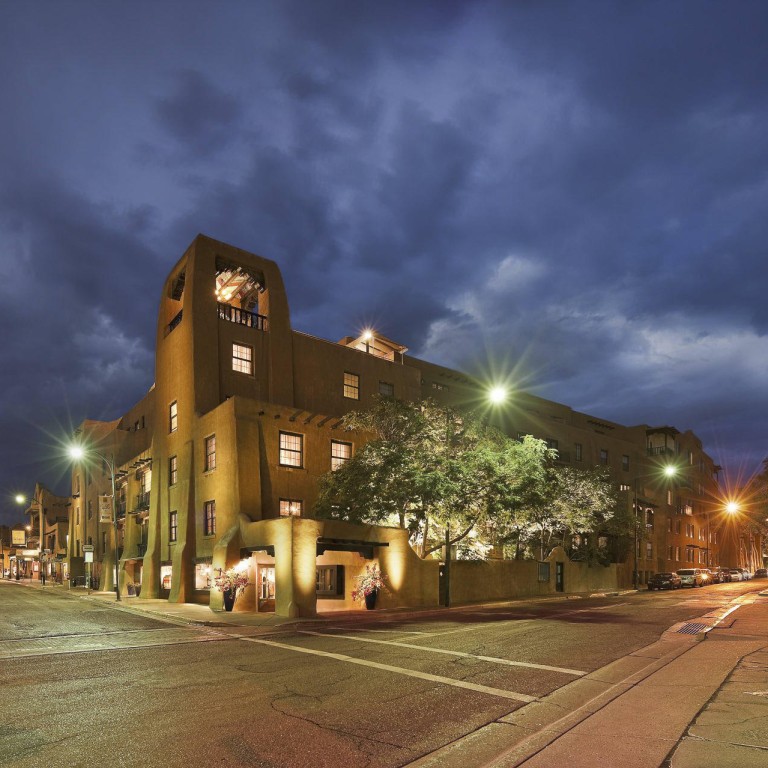
La Fonda, a luxurious 'inn' in Santa Fe that's steeped in art and history
A lodging has stood at the same spot in the New Mexico town perhaps since the 17th century, writes Mark Footer
Once the "inn at the end of the Santa Fe Trail", a lodging has stood on this spot since at least 1833 (before New Mexico was annexed to the United States) and perhaps as far back as 1610. From that later date, Mary Donoho, the first Anglo-American woman known to have travelled along the trail - a transport route that began in Franklin, Missouri - ran a hotel here, the forerunner to today's La Fonda (the word means "inn" in Spanish). The exterior (above) is a mix of Spanish, (local village) and Moorish elements.
That is quite the understatement, in regard to both the hotel and Santa Fe ("holy faith") itself, the oldest state capital in the US. Each guest will find in their room two books: , which explains the history of the hotel, and , which is a guide to the millions of dollars worth of work hanging in the rooms and along the corridors. Instead of reading all about it, though, take a tour with a resident docent.
"We are thinking of calling them something else," says director of marketing Jayne Weiske, laughing, "because no one [who stays] knows what a docent is." What they are are historian-guides who give guests a better understanding of the hotel and the stories behind the artwork (best experienced online at the Art of La Fonda page on Pinterest). Above the concierge desk, for instance, there is a sign that says "Indian detour". If you hadn't taken the docent tour, you may not be aware that that is an original from the late 1920s, when the hotel was an outpost of the Fred Harvey Company and arranged for tourists to be taken to see New Mexico's sights and places of cultural interest.

When John Wayne stayed at La Fonda - perhaps instinctively twitching aside the embroidered curtains to make sure no baddies were tying up their horses in the street below - he no doubt found himself in familiar surroundings. Staying here, it's easy to imagine you're the guest of a generous, yet no doubt fiendish, landowner with a Spanish accent and an evil laugh. The solid, comfy bedrooms of his hacienda are furnished with handcrafted replicas of 20s pieces and benefit from historically authentic decor. The artwork is unique to each room and the tiling is unique to each bathroom. When the hotel was last refurbished, many of the old bedheads - each unique and painted with flowers - were put up as pieces of art in the corridors.
Very well; the hotel restaurant, La Plazuela (above), was, until the 70s, an open courtyard. It is now covered but still airy and light; and a wonderful place in which to feast on a New Mexico burrito for breakfast; beef, chicken or shrimp fajitas de Santa Fe for lunch; and wild boar for dinner, among many other local specialities. Painted panes of glass - every one unique - adorn the windows that surround La Plazuela. Similar panes are found throughout the hotel; there are more than 400 in total.

Plenty more history; the plaza is home to the Palace of the Governors (above), an adobe structure that dates back to 1610 and outside of which gather Native Americans to sell handmade jewellery. Also within strolling distance are the Roman Catholic Cathedral Basilica of St Francis of Assisi (completed in 1886); the Gothic Revival style Loretto Chapel, with its "mysterious spiral staircase", which appears to defy the laws of physics; and the Museum of Contemporary Native Arts. The area is dominated by shops and stalls selling Native American trinkets, jewellery, rugs, pottery and other arts and crafts of the tasteful variety.
In the 1927 novel - set in the mid-19th century and recommended reading for anyone visiting this part of New Mexico - author Willa Cather describes Santa Fe as "a thin wavering adobe town … a green plaza … at one end a church [where the cathedral now stands] with two earthen towers that rose high above the flatness. The long main street began at the church, the town seemed to flow from it like a stream from a spring. The church towers, and all the low adobe houses, were rose colour … a little darker in tone than the amphitheatre of hills behind; and periodically the plumes of poplars flashed like gracious accent marks - inclining and recovering themselves in the wind."
Santa Fe hasn't changed much.


